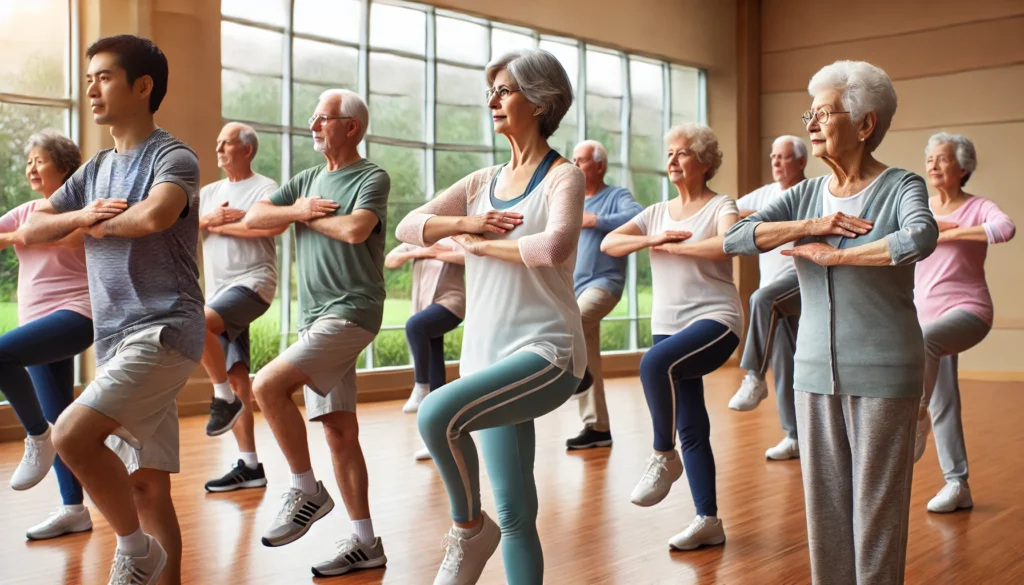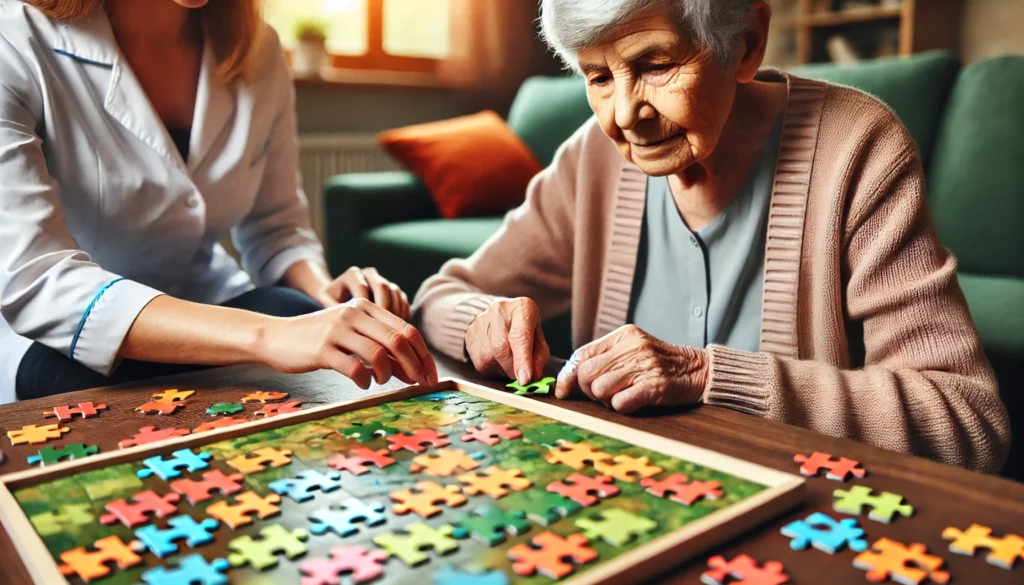Dementia encompasses a group of symptoms affecting cognitive function, with Alzheimer’s being the most common form. While there is currently no cure, research has shown that physical and mental exercises can slow the progression of symptoms, fostering improved mental acuity and emotional well-being.
You may also like: Effective Techniques for Memory Practice Improvement
Types of Dementia
Dementia is not a single disease but a general term for several cognitive impairments. Alzheimer’s disease, vascular dementia, Lewy body dementia, and frontotemporal dementia are among the most prevalent types. Each type affects different areas of the brain, leading to varied symptoms. Understanding these distinctions is crucial for tailoring exercise routines to individual needs.
Symptoms and Diagnosis
Symptoms of dementia can range from mild memory loss to severe cognitive impairments that affect daily functioning. Early diagnosis is key to managing the condition effectively. Healthcare professionals use cognitive tests, medical history, and brain imaging to diagnose the type and extent of dementia. This understanding helps in crafting personalized exercise routines that cater to the specific challenges faced by each patient.
The Emotional and Social Impact
The impact of dementia extends beyond cognitive decline, affecting emotional well-being and social interactions. Individuals with dementia may experience anxiety, depression, and isolation. Exercises, both physical and cognitive, can help mitigate these effects by fostering a sense of achievement and promoting social engagement.
The Role of Exercise in Dementia Care
Regular exercise is beneficial not only for physical health but also for cognitive function. Studies indicate that exercise increases blood flow to the brain, which can stimulate the growth of new blood vessels and brain cells. Additionally, exercise may enhance mood, reduce stress, and improve sleep, all of which are crucial for individuals with dementia.
Scientific Insights into Exercise and Brain Health
Recent studies have shed light on the neurobiological benefits of exercise. Physical activity can lead to the production of brain-derived neurotrophic factor (BDNF), which supports neuron survival and growth. This is particularly beneficial for dementia patients, as it aids in preserving cognitive functions and slows the degeneration process.
The Psychological Benefits of Physical Activity
Exercise is known to release endorphins, which are chemicals in the brain that act as natural painkillers and mood elevators. For individuals with dementia, this can translate into reduced anxiety and depression. Engaging in regular physical activity also provides a sense of routine and normalcy, which can be comforting for those experiencing cognitive decline.
Social Aspects of Exercise
Group exercises or classes can offer social interaction, which is vital for emotional health. Socializing during exercise helps dementia patients build connections and reduces feelings of loneliness and isolation. This sense of community can be a powerful motivator for continued participation in exercise programs.
Physical Exercises for Dementia Patients
Engaging in physical activities can significantly benefit dementia sufferers. Here are some exercises that can be tailored to individual capabilities and preferences.
Aerobic Exercises
Aerobic exercises, such as walking, swimming, or cycling, are excellent for heart health and can improve overall brain function. These activities boost cardiovascular health, which is closely linked to cognitive health. Encouraging dementia patients to participate in aerobic exercises can help maintain mental sharpness and delay cognitive decline.
Walking Programs
Walking is one of the most accessible forms of aerobic exercise. It requires no special equipment and can be done indoors or outdoors. Creating a structured walking program tailored to the individual’s pace and stamina can encourage regular participation. Walking in a park or garden can also provide sensory stimulation, enhancing the overall experience.
Swimming for Cognitive and Physical Health
Swimming offers a low-impact, full-body workout that is gentle on the joints. The rhythmic nature of swimming can be soothing, while the water resistance provides excellent muscle strengthening. Swimming classes can also serve as a social event, promoting interaction with peers.
Cycling for Mental Stimulation
Cycling, whether on a stationary bike or outdoors, promotes cardiovascular health and enhances motor skills. Stationary cycling can be particularly beneficial for those with mobility issues, providing a safe environment to exercise without the risk of falls. Outdoor cycling adds the element of environmental interaction, which can be stimulating for the senses.
Strength Training
Strength training exercises, including lifting light weights or using resistance bands, can enhance muscle strength, balance, and coordination. These exercises can be particularly beneficial in preventing falls, a common concern for dementia patients.
Resistance Band Workouts
Resistance bands are versatile tools for strength training. They can be used to perform a variety of exercises targeting different muscle groups. For dementia patients, resistance bands offer a safe and adjustable form of resistance that can be easily adapted to their strength levels.
Light Weight Lifting
Lifting light weights can improve muscle tone and bone density. It’s important to focus on proper form and technique to prevent injuries. Caregivers can assist in ensuring exercises are performed safely, gradually increasing the weight as strength improves.
Balance and Stability Training
Incorporating balance exercises, such as standing on one leg or using a balance board, can enhance stability. These exercises are crucial for fall prevention and can be integrated into daily routines, such as standing on one foot while brushing teeth.

Flexibility and Balance Exercises
Activities like yoga and tai chi focus on flexibility and balance, helping to improve stability and reduce the risk of falls. These exercises also promote relaxation and mindfulness, which can alleviate anxiety and stress in dementia patients.
Yoga for Flexibility and Calm
Yoga combines physical postures, breathing exercises, and meditation. It helps improve flexibility, strength, and mental focus. Gentle yoga routines can be tailored to accommodate varying levels of mobility, and the meditative aspects can promote a sense of calm and relaxation.
Tai Chi for Balance and Mindfulness
Tai chi is a series of slow, deliberate movements that enhance balance and coordination. It is particularly effective for improving proprioception, the body’s ability to sense movement and position. The mindful nature of tai chi encourages present-moment awareness, reducing stress and anxiety.
Simple Stretching Routines
Incorporating regular stretching into daily activities can maintain flexibility and joint health. Simple stretches, such as shoulder rolls or seated toe touches, can be done at home and require minimal time and effort. These routines can be especially beneficial for individuals with limited mobility.
Cognitive Exercises for Dementia Sufferers
In addition to physical exercises, cognitive activities are crucial for engaging the brain and maintaining cognitive health.
Puzzles and Games
Puzzles, crosswords, and board games are excellent cognitive exercises that challenge the brain and improve problem-solving skills. These activities encourage strategic thinking and can be tailored to the individual’s ability level, making them accessible for all stages of dementia.
Jigsaw Puzzles for Cognitive Engagement
Jigsaw puzzles enhance visual-spatial reasoning and concentration. Selecting puzzles with larger pieces and simpler images can accommodate those with advanced dementia. Completing puzzles can provide a sense of achievement and stimulate social interaction when done in groups.
Crossword Puzzles and Word Games
Crosswords and word games like Scrabble stimulate language and memory skills. These activities can be adjusted for difficulty by using simpler words and offering hints. Engaging in word games can also promote communication skills and vocabulary.
Board Games for Social Interaction
Board games offer a combination of strategic thinking and social interaction. Games like chess, checkers, or memory card games can be adapted to suit different cognitive levels. Playing board games with family or peers can enhance social bonds and provide enjoyment.
Memory Exercises
Memory exercises, such as recalling past events or engaging in memory-based games, can help dementia patients maintain their recollection skills. Simple activities like discussing family history or looking through photo albums can also stimulate memory recall.
Creating a Dementia Exercise Routine
Designing a dementia exercise routine requires consideration of the individual’s abilities, interests, and health status. Here are some tips for creating an effective exercise program:
Start Slow and Progress Gradually
Begin with short, simple exercises and gradually increase the duration and complexity as the individual becomes more comfortable. It’s essential to avoid overwhelming dementia patients, as this can lead to frustration and disengagement.
Assessing Initial Abilities
Before starting a routine, assess the individual’s current physical and cognitive abilities. This assessment can guide the selection of appropriate exercises and ensure the routine is neither too easy nor too challenging. Consulting with healthcare professionals can provide valuable insights into the individual’s capabilities.
Building a Foundation
Focus on establishing a strong foundation with basic exercises. This includes simple stretches, short walks, or basic puzzles. Building confidence and familiarity with these activities can encourage continued participation and set the stage for more advanced exercises.
Incremental Progression
Gradually introduce new exercises or increase the intensity of current activities. This progression should be based on the individual’s comfort level and progress. Regularly updating the routine keeps it engaging and prevents stagnation.
Encourage Consistency
Consistency is key when it comes to exercise. Encourage dementia patients to engage in physical and cognitive activities regularly to reap the maximum benefits. Establishing a routine can also provide structure and stability, which is beneficial for individuals with dementia.
Creating a Daily Schedule
Incorporate exercises into a daily schedule, aligning them with the individual’s natural rhythms and preferences. Morning exercises may suit early risers, while others may prefer afternoon sessions. Consistency in timing can help establish a routine and make exercise a regular part of the day.
Tracking Progress
Keep a record of the exercises performed and any notable improvements or challenges. This can help identify patterns, adjust routines, and celebrate achievements. Caregivers can use progress tracking as a motivational tool, highlighting improvements to encourage continued participation.
Adapting to Changes
Be prepared to adapt the routine based on changes in abilities or interests. Flexibility is crucial, as dementia patients may experience fluctuations in cognitive and physical function. Regularly reviewing and adjusting the routine ensures it remains relevant and effective.
Make it Enjoyable
Incorporate activities that the individual enjoys to maintain motivation and engagement. Whether it’s dancing, gardening, or playing a favorite game, enjoyment should be a priority in any exercise routine.
Personalizing Exercise Choices
Identify activities that the individual finds enjoyable and incorporate them into the routine. This personalization increases the likelihood of engagement and adherence. Familiar activities can also provide comfort and a sense of familiarity.
Incorporating Music and Movement
Music can be a powerful motivator during exercise. Incorporating favorite songs or rhythms into activities like dancing or walking can enhance enjoyment. The combination of music and movement can also stimulate multiple areas of the brain, promoting cognitive health.
Celebrating Achievements
Celebrate small victories and milestones, such as completing a new exercise or improving performance. Recognition and positive reinforcement can boost confidence and motivation. Celebrating achievements with family or peers can also strengthen social bonds.
Practical Advice for Caregivers and Health Professionals
Caregivers and health professionals play a critical role in supporting dementia patients. Here are some practical tips for facilitating engaging and effective exercise routines:
Personalize Activities
Tailor exercises to the individual’s preferences and abilities to ensure they are both enjoyable and achievable. Personalization can enhance motivation and participation, making the exercise routine more effective.
Understanding Individual Needs
Take time to understand the individual’s likes, dislikes, and capabilities. This understanding can guide the selection of exercises that resonate with the person, increasing the likelihood of engagement and enjoyment.

Customizing Exercise Plans
Design exercise plans that cater to the individual’s unique needs. This customization can involve adjusting the intensity, duration, or type of exercise based on the person’s health status and interests. Flexibility in planning ensures the routine remains relevant and effective.
Involving the Individual in Planning
Involve the individual in the planning process, allowing them to express preferences and make choices. This empowerment can boost motivation and commitment to the exercise routine, as it reflects their personal interests and goals.
Monitor Progress
Keep track of the individual’s progress and adjust the routine as needed to accommodate changes in ability or interest. Regular monitoring ensures the routine remains effective and aligned with the individual’s evolving needs.
Setting Realistic Goals
Set achievable goals that align with the individual’s abilities and interests. These goals can serve as benchmarks for progress and provide a sense of accomplishment. Celebrating the achievement of goals can motivate continued participation.
Observing Physical and Cognitive Changes
Pay attention to any changes in physical or cognitive abilities. These observations can guide adjustments to the routine, ensuring it remains safe and effective. Regular communication with healthcare professionals can provide additional insights into necessary modifications.
Adjusting to Changes
Be prepared to modify the routine based on changes in the individual’s condition or preferences. This flexibility ensures the routine continues to meet the person’s needs and supports their well-being.
Offer Encouragement
Provide positive reinforcement and encouragement to boost confidence and motivation. Encouragement can foster a positive attitude towards exercise and increase adherence to the routine.
Building a Supportive Environment
Create a supportive and encouraging environment that fosters participation and enjoyment. This includes offering praise for effort and progress, as well as providing assistance when needed. A positive atmosphere can enhance the overall exercise experience.
Encouraging Social Interaction
Facilitate opportunities for social interaction during exercises, such as group classes or partner activities. Social engagement can enhance motivation and make the exercise routine more enjoyable. Encouraging interaction with peers can also provide emotional support.
Celebrating Milestones
Celebrate achievements and milestones, both big and small. Recognition of progress can boost self-esteem and reinforce the value of the exercise routine. Celebrating successes with family or friends can also strengthen social bonds.
Ensure Safety
Prioritize safety by providing a safe environment and using appropriate equipment to prevent injuries. Safety considerations are crucial for maintaining the well-being of dementia patients during exercise.
Assessing the Exercise Environment
Evaluate the exercise environment to ensure it is safe and accessible. This includes checking for potential hazards, ensuring adequate lighting, and providing supportive surfaces. A safe environment minimizes the risk of accidents and injuries.
Using Appropriate Equipment
Select exercise equipment that is suitable for the individual’s abilities and needs. This may include supportive shoes, resistance bands, or stability aids. Proper equipment can enhance the safety and effectiveness of the exercise routine.
Supervising Exercises
Supervise exercises to ensure they are performed safely and correctly. Caregivers or health professionals can provide guidance and assistance, reducing the risk of injuries. Supervision also allows for immediate response to any issues that may arise.
Future Implications and Trends in Dementia Care
As research continues to uncover the benefits of exercise for cognitive health, future trends in dementia care are likely to emphasize personalized exercise programs and innovative technologies. Virtual reality, for example, is emerging as a tool to engage dementia patients in immersive cognitive exercises, offering new opportunities for enhancing brain health.
Personalized Exercise Programs
The future of dementia care will likely focus on highly personalized exercise programs that cater to individual needs and preferences. Advances in technology, such as wearable fitness trackers and personalized health apps, will enable tailored exercise routines that adapt to the individual’s condition and progress.
Technology and Virtual Reality
Virtual reality (VR) is emerging as a promising tool for cognitive stimulation in dementia care. VR experiences can provide immersive environments that engage multiple senses and promote cognitive activity. These technologies can offer novel ways to engage dementia patients, providing cognitive challenges and social interaction in a controlled setting.
Integration of Multidisciplinary Approaches
Future dementia care will likely integrate multidisciplinary approaches, combining exercise with other therapeutic interventions. This holistic approach can enhance overall well-being and address various aspects of dementia, from cognitive function to emotional health. Collaboration between healthcare professionals, caregivers, and researchers will be key to developing comprehensive care strategies.

Conclusion
Exercises designed for dementia patients can significantly improve cognitive function, emotional well-being, and overall quality of life. By incorporating a mix of physical and cognitive activities into daily routines, caregivers and health professionals can support individuals with dementia in maintaining their independence and mental acuity. As the understanding of dementia continues to evolve, embracing these engaging exercises will remain a cornerstone of effective dementia care. The future of dementia care promises to be dynamic, with personalized exercise programs and innovative technologies paving the way for enhanced cognitive health and improved quality of life for those affected by this challenging condition.
Further Reading:
Simple Memory Exercises for Dementia
25+ Physical Therapy Exercises for Dementia
Important Note: The information contained in this article is for general informational purposes only, and should not be construed as health or medical advice, nor is it intended to diagnose, prevent, treat, or cure any disease or health condition. Before embarking on any diet, fitness regimen, or program of nutritional supplementation, it is advisable to consult your healthcare professional in order to determine its safety and probable efficacy in terms of your individual state of health.
Regarding Nutritional Supplements Or Other Non-Prescription Health Products: If any nutritional supplements or other non-prescription health products are mentioned in the foregoing article, any claims or statements made about them have not been evaluated by the U.S. Food and Drug Administration, and such nutritional supplements or other health products are not intended to diagnose, treat, cure, or prevent any disease.


